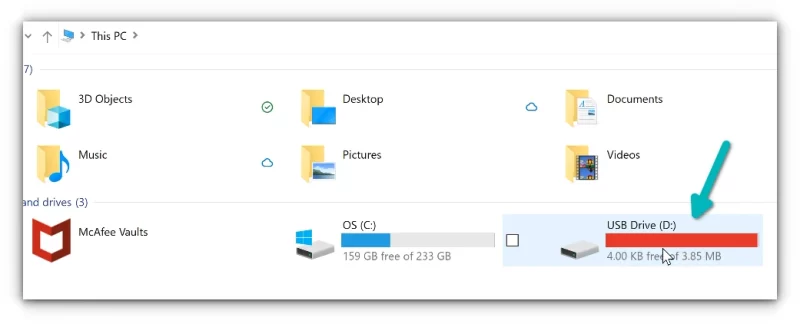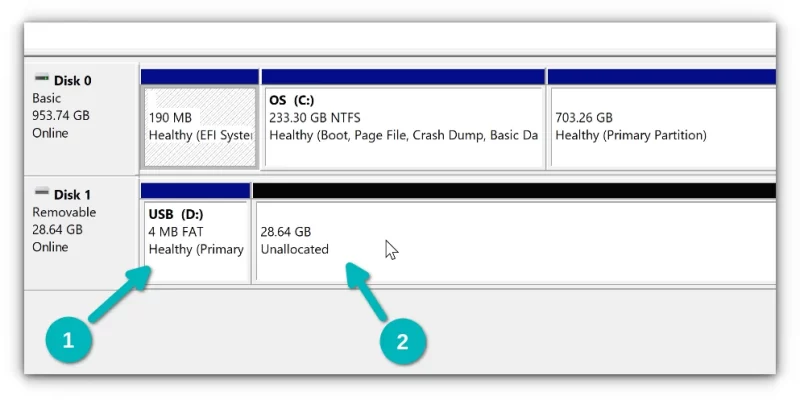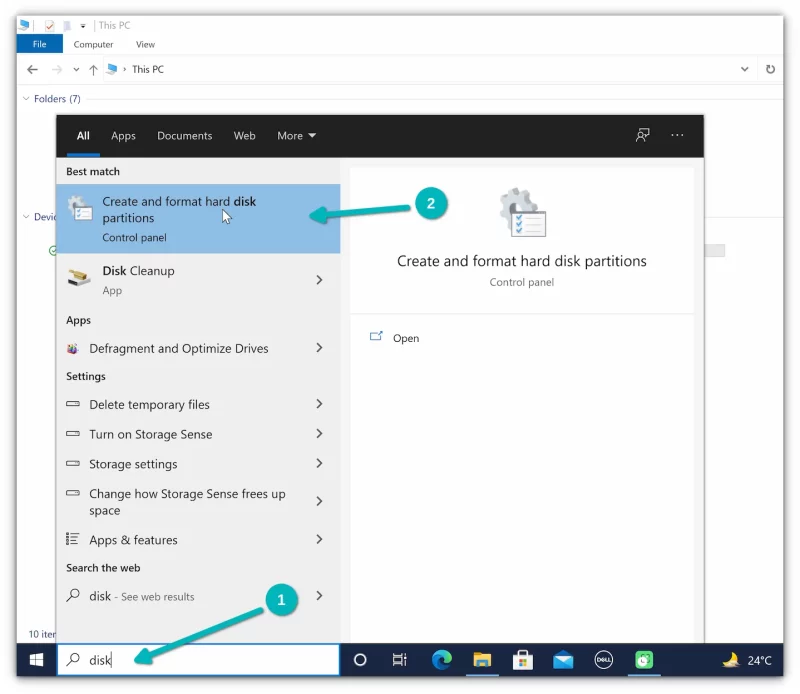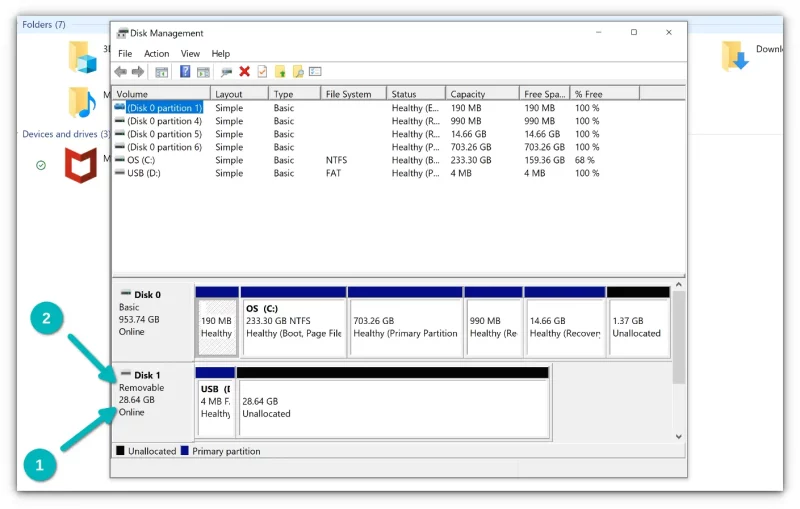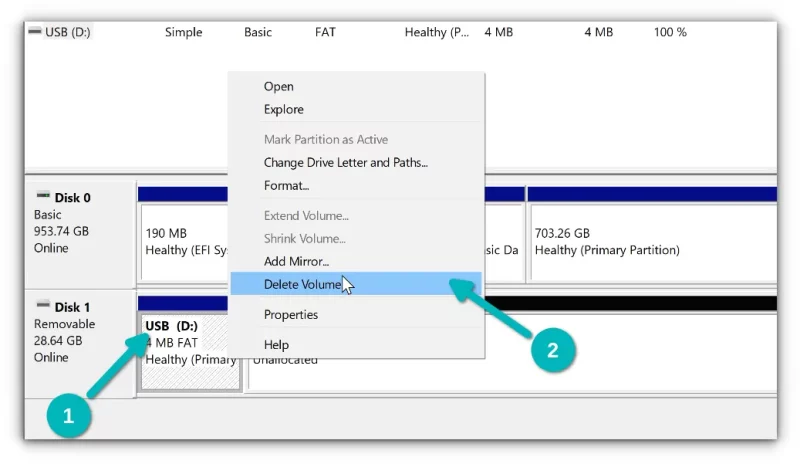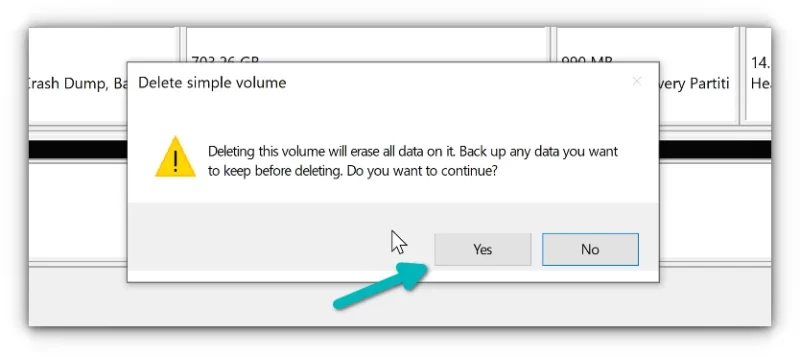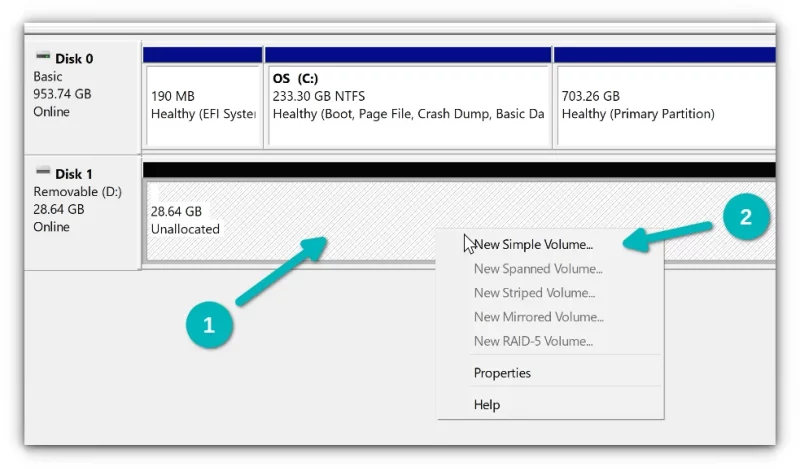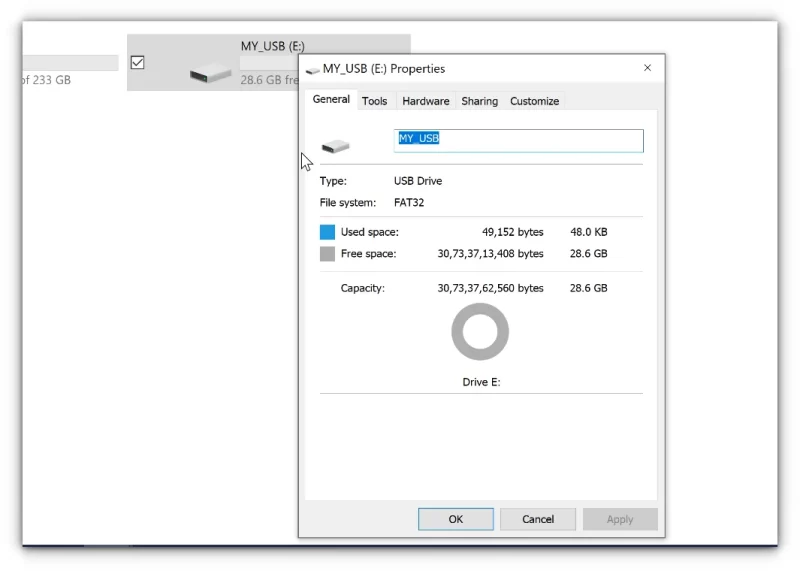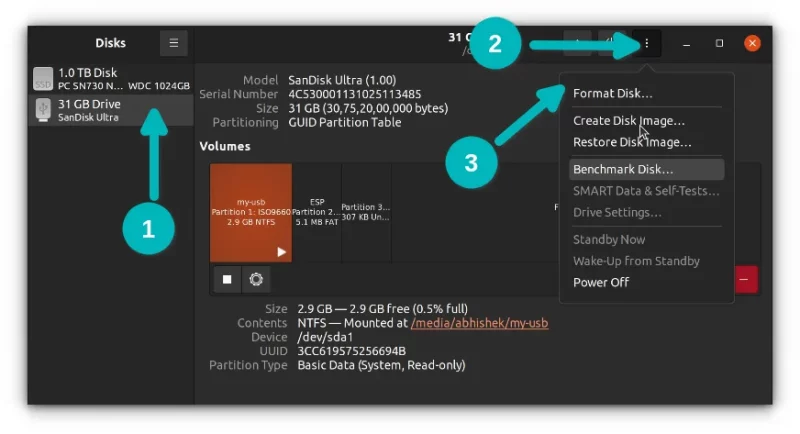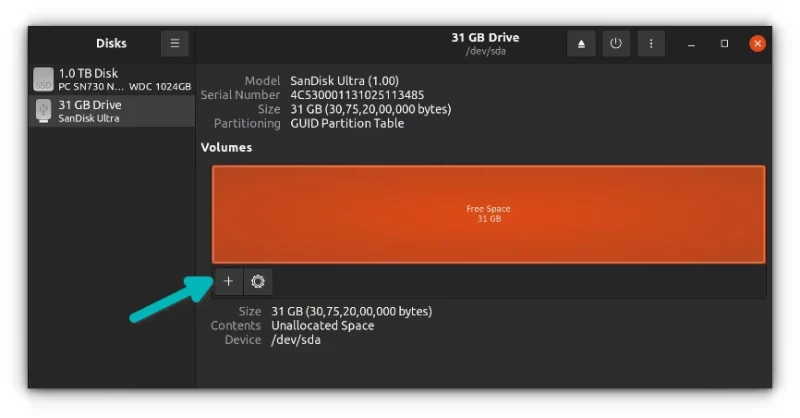- How re-format a Linux-USB in Windows?
- 3 Answers 3
- Format linux USB drive in Windows (not visible in file explorer)
- Only 4 MB? How to Fix USB ‘Destroyed’ by Etcher and Rufus After Creating Live Linux USB
- Formatting the live Linux USB created by Rufus or Etcher [In Windows]
- Step 1:
- Step 2:
- Formatting live Linux USB on Linux
- Conclusion
- Format a Linux USB or SD Card Using Windows
How re-format a Linux-USB in Windows?
#1. Say that I have an USB with some windows-files. If I put the USB in a windows computer, the windows explorer will open and I can access the files. #2. Say that I have an unformatted USB and put it in a windows computer. Now a window will pop up saying that I need to format the unit before I can use it (and I can format directly from that windows). #3. Say that I have created a bootable USB for instaling a linux distro, and then put the USB in a windows computer . nothing happens, because windows don’t recognize the linux file system. How do I format that Linux-USB in windows so windows can use it? If I open windows explorer, right click and choose manage, then open disk management — I normally can format an USB. When I try to format the Linux-USB, the window from #2 above appear and interrupt the formatting. If I try to format from that window, the windows appears again and interrupts itself in an endless loop. If I open cmd, then diskpart, the same thing happens: an endless loop with the windows from #2. How do I format a Linux-USB in windows? (normally this isn’t a problem, I just format the USB to FAT32 with gparted on a linux machine, but yesterday I was stuck with only a windows machine and only one Linux-USB and I needed an USB)
3 Answers 3
Format linux USB drive in Windows (not visible in file explorer)
Launch command prompt or Powershell, run the command diskpart . The Diskpart command line application will open.
First, type list disk to show all of the disks connected to the PC. Now determine which of these is your Linux disk. You can usually identify it based on the sizes listed. You will want to be 100% sure of your selection here because the following commands will wipe ALL DATA from whichever disk you select.
Select the disk by using the command select disk X where X is the number of your disk from the previous command. Once you have selected your disk, use clean to remove all existing partitions.
Create a new partition with create partition primary and then mark it as active . Finally, we can format the disk with format fs=Fat32 quick . Now your USB drive or SD card is ready to be used again.
For quick reference, here are all of the commands in order:
diskpart list disk select disk X clean create partition primary active format fs=Fat32 quick Only 4 MB? How to Fix USB ‘Destroyed’ by Etcher and Rufus After Creating Live Linux USB
Here’s the scenario. You used Etcher or Rufus tools to create a bootable, live Linux USB in Windows or perhaps in Linux.
You used it to install Linux and the purpose of the USB is accomplished. Now you want to format this USB and use it for the regular data transfer or storage.
You plug it in your Windows system and to your surprise, the disk capacity of the USB is just 4 MB.
You try to format it and it probably won’t let you do that. Even if you manage to format it, the size of the USB is now shrunk to just 4 MB from the usual 8 GB, 16 GB or 32 GB.
Have you lost your USB? Not really. Your USB is not completely destroyed. You can still format it with a little trick and use it comfortably.
Let me show how to restore the bootable USB to a usable state in both Windows and Linux.
Formatting the live Linux USB created by Rufus or Etcher [In Windows]
You see only 4 MB of disk space in Windows. Do you know why? Because while creating the live Linux USB, the tool creates a 4 MB of EFI partition in FAT 32 filesystem. The other partition(s) is in Linux’s Ext4 filesystem which is not recognized by Windows.
This is why your Windows system only sees the EFI partition of 4 MB and shows the USB size as 4 MB.
All in all, what you need to do is to delete all the partition on the USB disk, create a new NTFS or FAT32 partition from the free space you got from deleting the existing partitions. That’s it.
Let me show the steps in detail.
Step 1:
Go to the Windows menu and look for the Disk Management tool.
Start this tool and it will show all the disks present on your computer. This includes the plugged-in USB, of course.
This is very important to select the correct disk. Identify which one it is from the size of the USB disk or from the ‘Removable’ tag.
Step 2:
The idea is to delete any existing partition present on the USB disk. The unallocated space cannot be deleted but that’s okay.
Right click on the partition and click Delete Volume.
When asked for your confirmation, press Yes.
Your aim is to have only a single block of unallocated space. When you see that, right click on it and click on “New Simple Volume” to create a partition.
The next steps are simple. Click on Next, select the entire available space, assign a letter to it, select the file system (FAT 32 or NTFS) and format it.
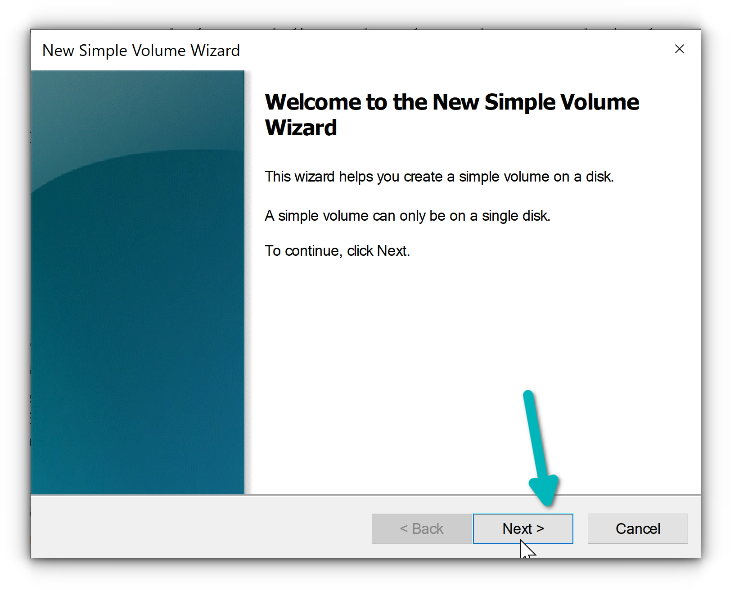
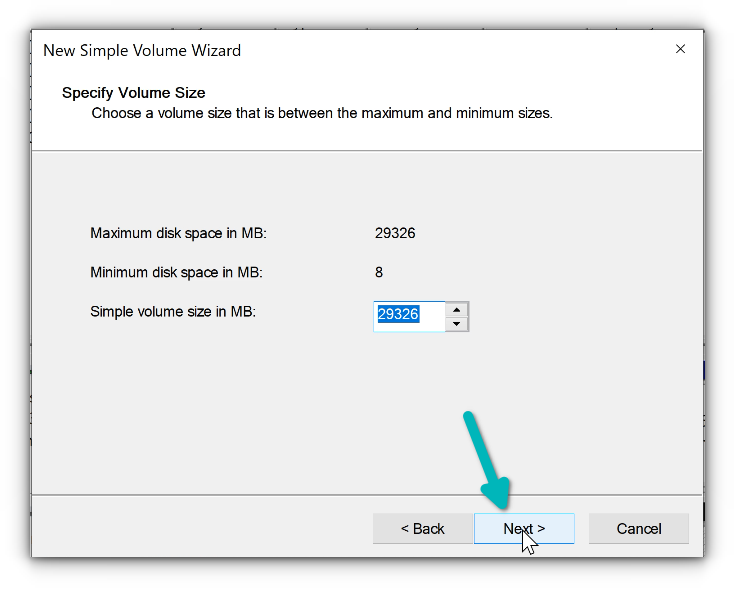
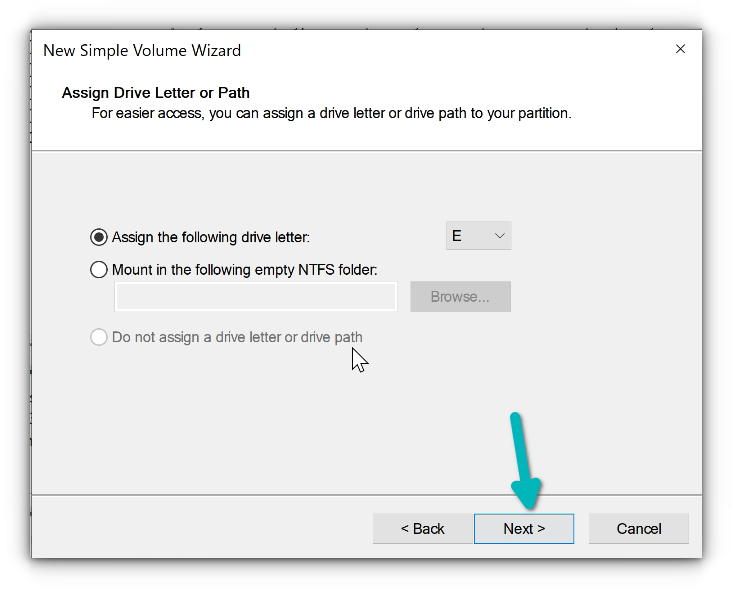
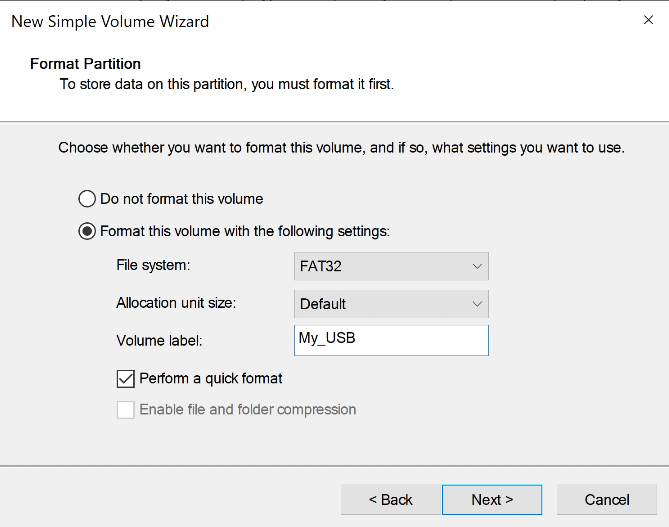

Once that is done, you’ll see that the USB has returned to normal state and you can start copy-pasting data to it.
You can use your USB as before now.
These steps were for Windows. What if you use Linux?
Formatting live Linux USB on Linux
I have noticed that live USB created by Etcher and such tools often create refuse to be formatted properly by the right click format option in the file manager.
As an alternative, you can do what you did in Windows: delete existing partitions and create a new partition with the entire free space.
Use the GNOME Disks tool here. It is already installed on Ubuntu and many other Linux distributions.
Again, make sure that you have selected the external USB disk here.
You’ll see various partitions on the USB disk. Try and format the disk from the menu above.
If that does not work, delete the partitions individually one by one and then make the entire USB as free space.
When you have the entire free space created, click on the + sign to create a partition on it in NTFS or FAT32 filesystem.
Create the partition with NTFS (or FAT 32), name it something appropriate and then you can enjoy the USB like it was before.
Conclusion
Tools like Rufus and Etcher don’t really destroy your USB. This is how they function, by creating a different filesystem on the disk. But then the operating system doesn’t understand it properly.
The good thing is that it can be fixed with only a little effort. I hope you too were able to fix it. If not, share your issue with me and I’ll try to help.
Format a Linux USB or SD Card Using Windows
You may have noticed that if you connect a disk with Linux partitions to your Windows box, that you cannot view all of the files or the size of the drive seems to be reported incorrectly. Here is a super quick way to format a Linux USB drive or SD card on a Windows PC using Diskpart so that it can be repurposed.
Start by launching a command prompt or Powershell session, then run the command diskpart . This will open the Diskpart command line application in a new window.
From here, start by using list disk to show all of the disks connected to the PC. Now determine which of these is your Linux disk. You can usually identify it based on the sizes listed. You will want to be 100% sure of your selection here because the following commands will wipe ALL DATA from whichever disk you select.
Select the disk by using the command select disk X where X is the number of your disk from the previous command.
Once you have selected your disk, use clean to remove all existing partitions. Create a new partition with create partition primary and then mark it as active .
Finally, we can format the disk with format fs=Fat32 quick . Now your USB drive or SD card is ready to be used again.
For quick reference, here are all of the commands in order:
diskpart list disk select disk X clean create partition primary active format fs=Fat32 quick Note: If your disk is larger than 32gb you can format it using fs=exFat instead of Fat32 to support larger capacities.
Updated: March 04, 2020
